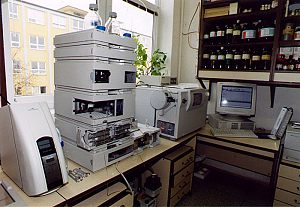|
|
Úvodní stránka /
Introduction |
Má práce / My work |
Analytická Fyziologie - Analytical Physiology
Proteomic Laboratory, Institute of Physiology ASCR - December 2022: functional laboratory was abolished, I left the Institute of Physiology
Česky English Instruments Sources (Links)
Included in the list of 2 % of the most cited scientists from all fields (prepared by Elsevier, SciTech Strategies and John P. A. Ioannidis from University of Standford)
Single recent year: 2019, 2022
Career-long data: 2019, 2020, 2021, 2022
Journal of Separation Science, John Wiley & Sons: We are excited to share that your research, published in Journal of Separation Science, is among the top 10% most downloaded papers! (Ivan Mikšík: Coupling of CE-MS for protein and peptide analysis. Jourmal of Separation Science, 42:385-397, 2019. link)

Zuby bez kazu? - video
45th International Symposium on High Performance Liquid Phase Separations and Related Techniques, Prague, June 18-22, 2017
Photographs from the conference HPLC 2017
Česky
Přednášky předmětu Analýza biologických materiálů - Univerzita Pardubice, FChT, Katedra biologických a biochemických vědPracoval jsem ve Fyziologickém ústavu AV ČR< (Oddělení pro analýzu biologických materiálů).


Hlavní oblasti zájmu:
Vývoj nových metod pro analýzu širokého spektra fyziologicky (biologicky) významných látek pomocí kapilární elektroforézy a chromatografie (steroidy, aminokyseliny, peptidy, oxo-látky, vitaminy, mastné kyseliny, pigmenty atd.). Analýza přirozených a modifikovaných peptidů/proteinů. Fyziologie a chemie pojivové tkáně a jejích příčných vazeb. Aplikace analytické chemie (kapilární elektroforézy a vysokoúčinné kapalinové chromatografie spřažené s hmotnostní detekcí) pro analýzu biologických (fyziologických) funkcí organismu. Rovněž působím jako ornitolog jak v oblasti biochemické analýzy, tak i v „polní“ ornitologii.
Seznam publikací
Curriculum Vitae
Fotografie z konference ITP 2011
Fotografie z konference MSB 2010
Fotografie z konference Chiranal 2010
Fotografie z konference Chiranal 2007
Fotografie z konference ITP 2008
Fotografie z konference Centra výzkumu chorob srdce a cév, Harrachov 2009 Centrum 2009
Fotografie z konference Sevilla - LACE 2009
Fotografie ze stěhování a instalace Q-TOF MaXis Q-TOF MaXis
English
I worked at Institute of Physiology, Academy of Sciences of the Czech republic (Department for Analysis of Biological Important Substances).


My work area:
Development of new methods for analysis of a broad spectrum of compounds by capillary electrophoresis and chromatography (steroids, amino acids, peptides, oxo-compounds, vitamins, fatty acids, pigments etc.). Analysis of native and modified peptides/proteins. Physiology and chemistry of connective tissue and their cross-links. Applications of analytical chemistry (capillary electrophoresis, high performance column and thin layer chromatography) to the analysis of biological (physiological) functions of the organism. I also acts as an ornithologist both in the area of biochemical analysis and field ornithology.
List of papers
Curriculum Vitae
Photographs from the conference ITP 2011
Photographs from the conference MSB 2010
Photographs from the conference Chiranal 2010
Photographs from the conference Chiranal 2007
Photographs from the conference ITP 2008
Photographs from the conference Sevilla - LACE 2009
Photographs from the movement and instalation Q-TOF MaXis Q-TOF MaXis
Instruments
|
MaXis - high-resolution tandem mass spectrometry (Q-TOF) (Bruker Daltonics)
|
|
|
Hewlett-Packard (Agilent) HPLC/MSD 1100 System. Detectors:
DAD, fluorescence, mass spectrometer (quadrupole), radioactive and evaporative
light-scattering (Polymer Labs.).
|
|
|
CE-MS coupling (Beckman P/ACE 5000 and Agilent MSD 1100) |
|
|
Capillary electrophoresis: two systems by Beckman (5500 and 5000) with three detectors: UV, DAD and LIF (laser-induced fluorescence). |
Sources (Links)
Links - odkaz (Click!)
Last update: June 23, 2017







